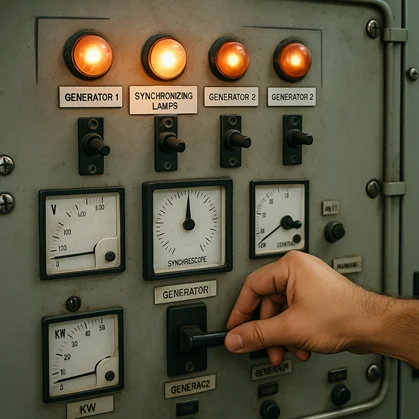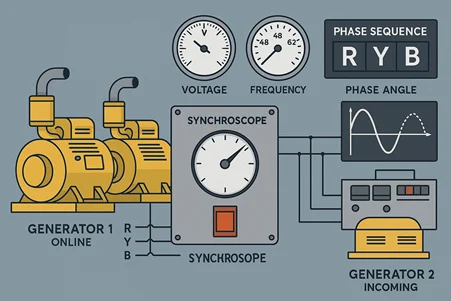“No Sync, No Power Simple as That”
Let’s be real on a ship, if the power goes out, everything stops. No lights, no pumps, no control systems, no AC, nothing. That’s why we’ve always got backup generators, but you can’t just press a button and slap them online. You’ve got to synchronize them first otherwise, things go south, fast. So let’s break this down like I’m explaining it to someone new on board no technical fluff, just how we actually do it out at sea.
What Does “Synchronizing” Even Mean?
It just means matching the incoming generator’s output (voltage, frequency, and phase) with what’s already running on the ship before we connect it to the system. Think of it like this: imagine two people jumping into a skipping rope. If they’re off even a little bit, someone’s getting smacked in the face. Same with generators if they’re not in sync, you’ll trip breakers, damage equipment, or even get a blackout.
Before we connect that second generator, here’s what we check:
- Voltage needs to match the running system
- Frequency should be same or slightly higher
- Phase Sequence must be in the same R-Y-B order
- Phase Angle basically, they need to rise and fall together
Mess up any of these, and you’re in trouble. Do it right, and they’ll work together like a tag team.
What We Actually Check Before Syncing
- Voltage
The voltage of the new generator must match the main one. If it’s too high, it’ll push reactive power. Too low, and it’ll suck it up. You don’t want either.
- Frequency
We usually make the incoming one just a little faster not by much, maybe 0.2–0.3 Hz. That way, when we sync, it doesn’t lag.
- Phase Sequence
If R-Y-B becomes R-B-Y, your system will go nuts. Always double-check it.
- Phase Angle
This one’s a bit tricky. You’re basically lining up the electrical “waves.” If they’re off, even by a bit, you’ll see arcs, hear the thud, and maybe even trip the system.

How We Actually Synchronize Them on Board
- Using a Synchroscope
This is the tool we mostly use on merchant ships.
- Start the standby generator (say D/G 2), and let the voltage settle.
- The synchroscope will show how the generator’s phase matches the running one.
- If the needle moves clockwise, D/G 2 is running a bit fast that’s what we want.
- Wait till the pointer gets close to 12 o’clock then hit the breaker.
We always close it just before 12, because there’s a tiny delay in contact.
- Three Lamp Method (When You Don’t Have Fancy Gear)
We put three bulbs across the phases:
- If they flicker slowly, it’s close to synced.
- If all go dark at the same time, boom close it right there.
- If they flicker fast, you’re way off. Wait.
Simple but it works especially during emergencies or training.
- Two Bright, One Dark Method
- L1 and L3 are reverse polarity, L2 normal.
- When L1 and L3 are glowing and L2 goes dark, you’re aligned.
- That’s your moment. Close it.
We used this in dry dock once when the sync panel was acting up old trick but still gold.
What Actually Happens Step-by-Step
Let’s say D/G 1 is running and we want to bring D/G 2 online. Here’s what we do:
- Start D/G 2
Let the voltage stabilize. AVR handles most of it.
- Match Parameters
Check voltage and frequency tweak the governor motor if needed.
- Look for Synchronization
Use the synchroscope or lamp method. Clockwise good. Wait till it’s almost 12.
- Close the Breaker
Right before 12 o’clock on the sync meter, close it. Don’t delay or overthink.
- Share the Load
Now slowly increase D/G 2’s load using the governor. Balance it out so both gensets aren’t overworked.
- Watch the Frequency
Keep it steady. If it starts drifting, adjust with the governor.
How to Take a Generator Offline (Safely)
Want to shut one generator down? Here’s how:
- Use the governor to reduce its load
- Once it’s below 5%, open the breaker
- Don’t wait too long if it hits reverse power, the relay will trip it anyway
If reverse power kicks in too often, the chief’s going to have a few words.
Common Mistakes to Avoid
- Don’t rush it syncing is all about patience and timing
- Never overload the main generator during shift
- Keep the sync panel clean no excuses
- Don’t rely only on emergency methods. Practice them regularly
- Never guess always check voltage, frequency, and angle
Quick Formula:
Ns = (120 × f) / P
- Ns = speed in RPM
- f = frequency
- P = number of poles in your alternator


